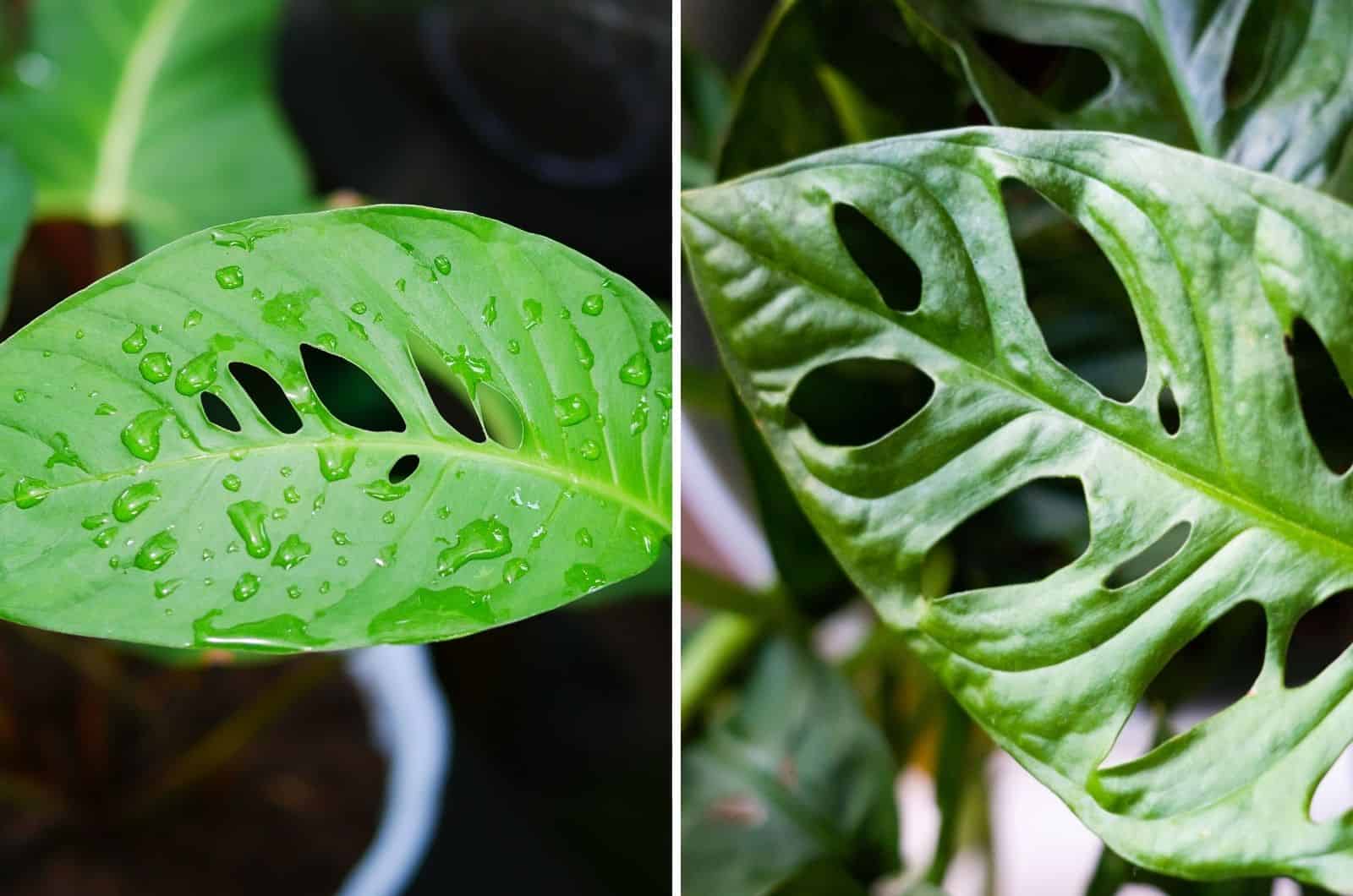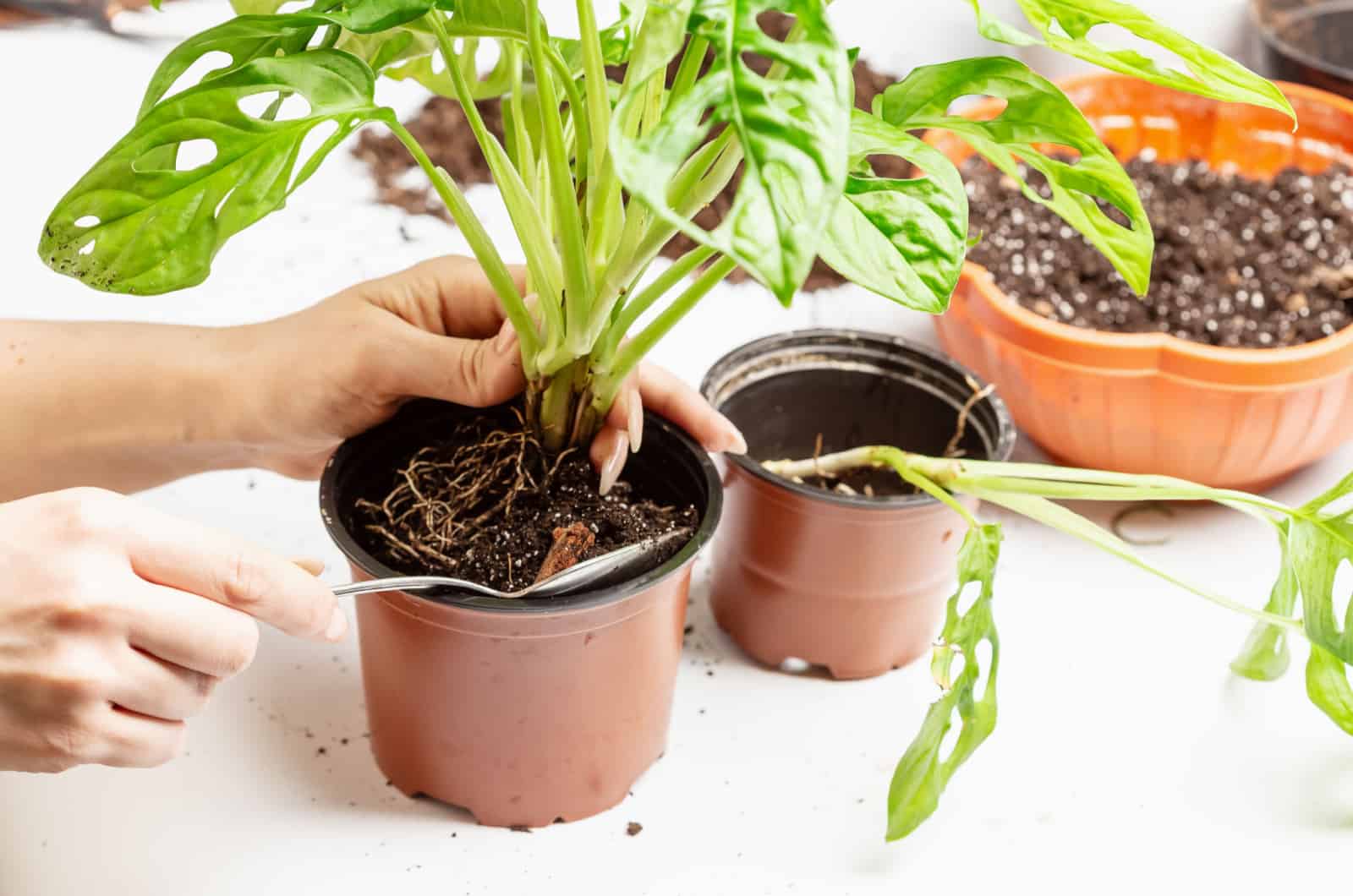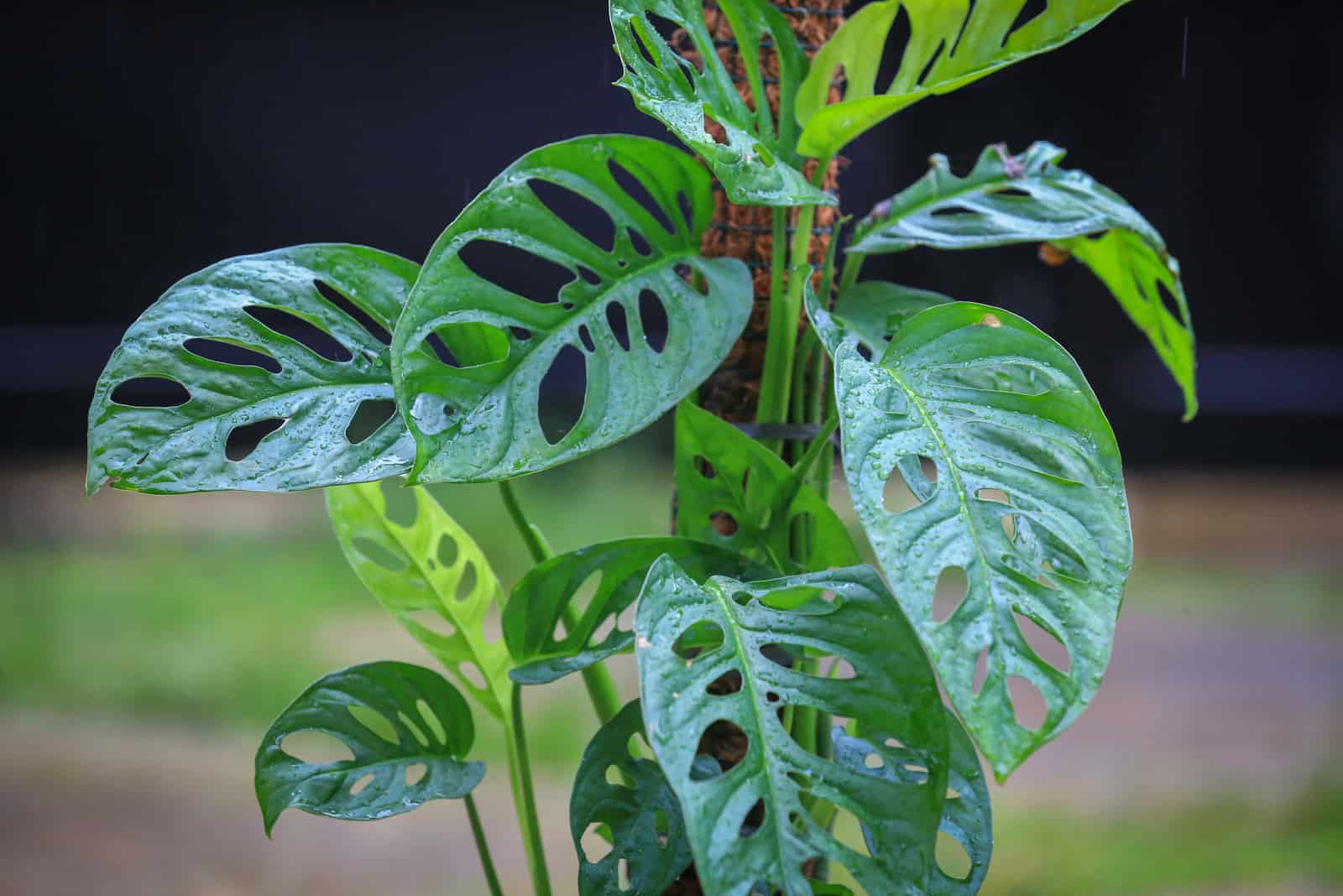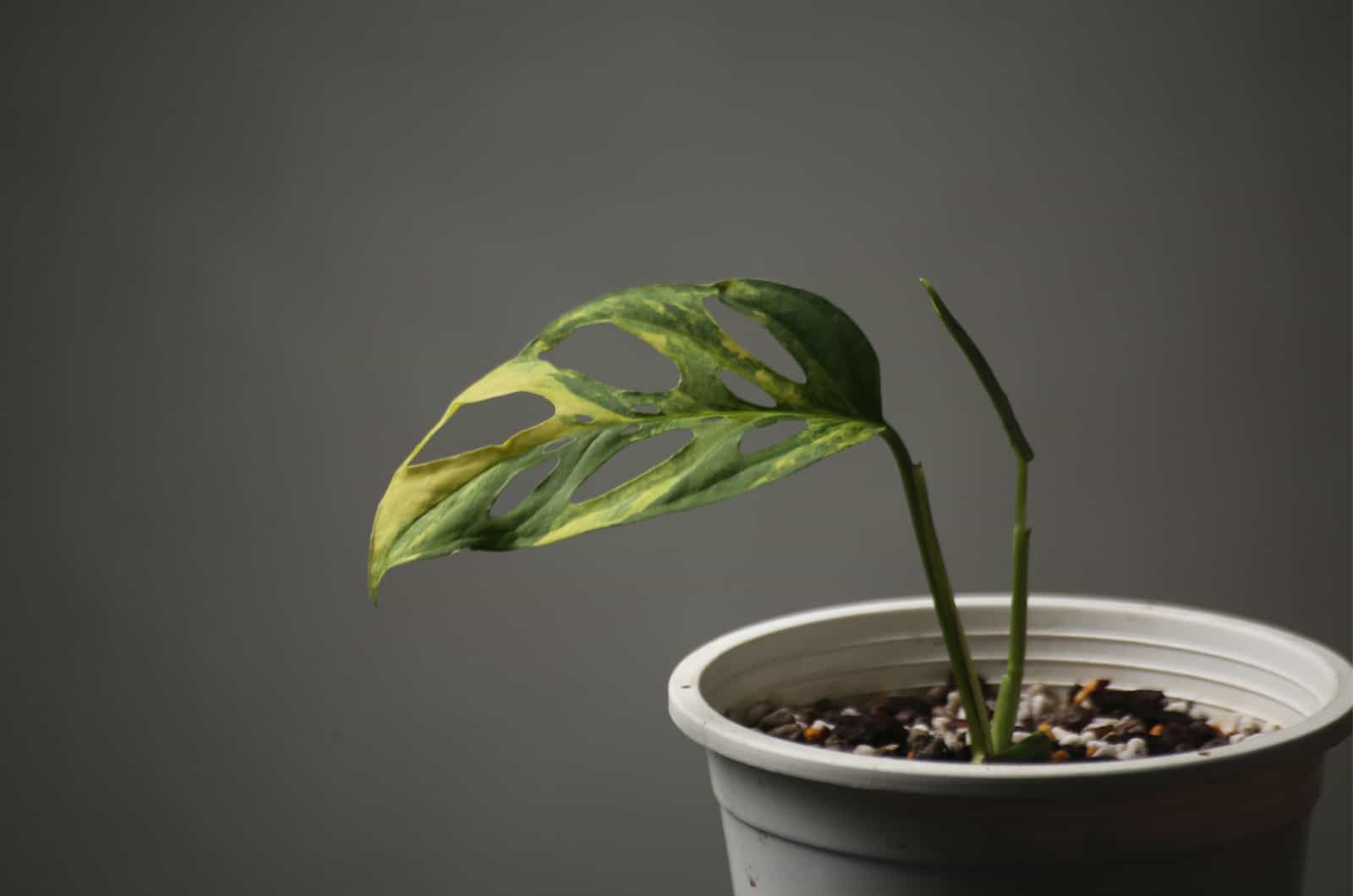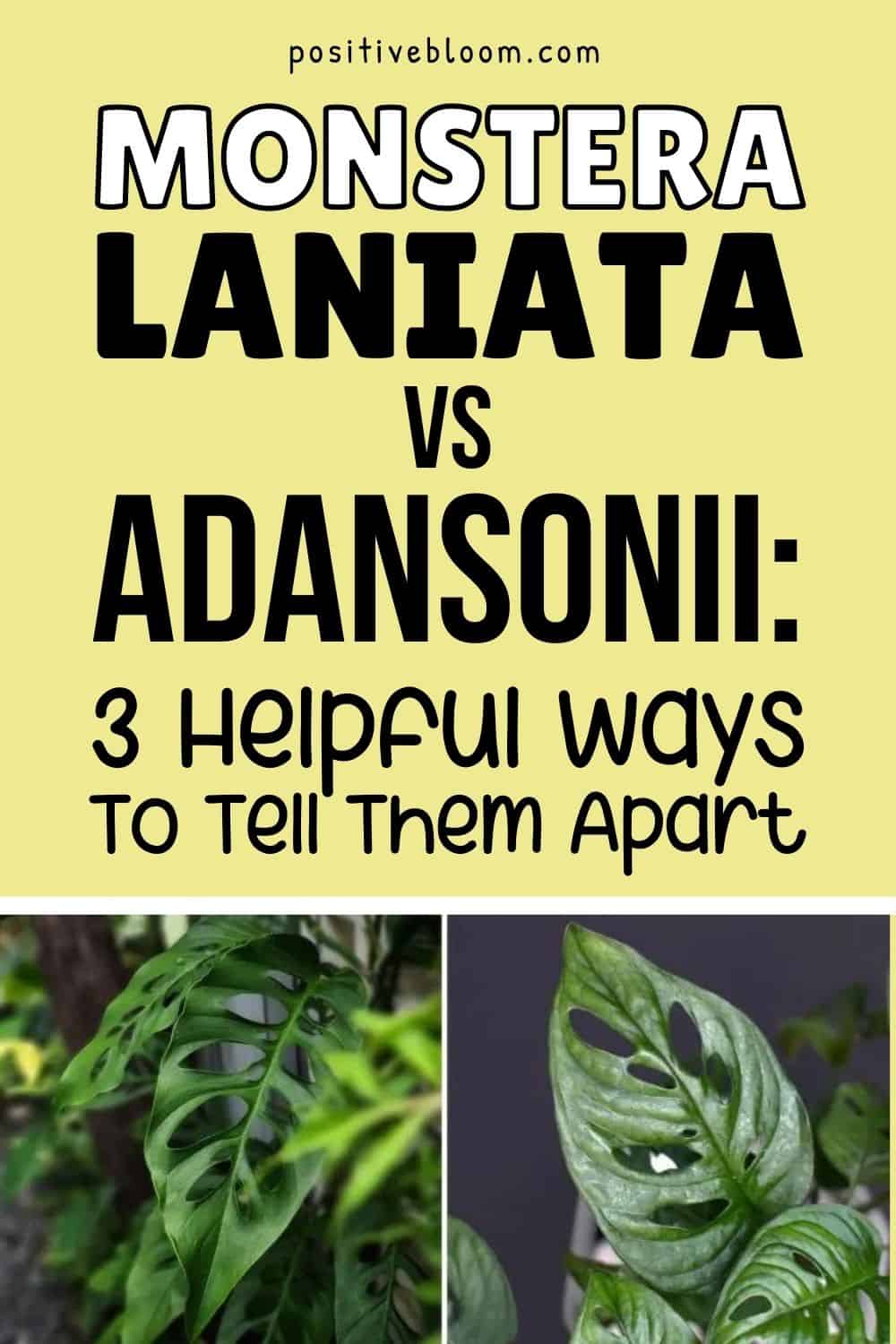With so many Monstera species out there, it can sometimes be hard to differentiate between all the species and subspecies.
Monstera plants are popular houseplants, mainly because they look absolutely stunning in any type of home decor, and also because they are low-maintenance and easy to take care of.
The most frequently seen Monsteras are definitely Monstera Adansonii varieties, which share the characteristic feature of dark-green leaves with fenestrations. If you have recently bought a new plant with similar features, how can you tell if you are dealing with Monstera Laniata or Adansonii?
Knowing what type of Monstera plant you are growing is important, especially if you are dealing with a variegated variety. However, most Monsteras have similar plant care requirements, so you can’t go wrong as long as you provide them with similar conditions.
Read our thorough analysis of Monstera Laniata vs Adansonii to help you distinguish between these types of Monstera plants.
Monstera Laniata Vs Adansonii: The Key Differences
It’s quite difficult to pinpoint the differences between these two plants, mostly because the Monstera Laniata is actually called Monstera Adansonii Laniata, which means that this plant is a subspecie of the Adansonii.
However, even though they are almost the same plant, there are still some clues that will help you differentiate between them, including their size, fenestrations, and leaf color.
Size
Monstera Adansonii var. Laniata belongs to the narrow form Adansonii varieties, but it tends to grow slightly larger than the other Adansonii plants. If you want to grow a small Monstera Adansonii variety, go for something like the Monstera Friedrichsthalii.
Leaves
Monstera Adansonii varieties are usually divided based on their leaves — that is, whether they grow round or narrow leaves. However, they can also be divided based on their variegation habits (Monstera Adansonii Variegata is a lot pricier than the rest of the varieties!).
However, the Monstera Laniata produces dark green leaves that have a much glossier appearance, especially if you look at their undersides. With them being larger in size, they also produce larger leaves.
When we look at our Adansonii, also known as the Swiss cheese plant, we can see that they have intense green leaves with a matte appearance on the undersides.
Fenestration
If you aren’t able to differentiate between these two indoor plants, you can also look at their fenestrations. This is a key feature that distinguishes Monsteras from other plants, but different fenestration patterns can also help you differentiate between Monstera varieties.
For instance, Monstera Laniata has symmetrical fenestrations unlike the Adansonii species, which have sporadic fenestrations.
These are the features that can help you distinguish a Monstera Laniata from the rest of the Monstera Adansonii subspecies. I always look at the undersides of the leaves to see if they have a glossy or matte appearance.
Monstera Laniata Vs Adansoni: Plant Care Guide
As you can see, these plants are practically the same. The Monstera Adansonii species originates from South America, belong to the same family (Araceae), and they also have a similar plant care guide.
Let’s take a look at the plant care guide for these glorious monsteras!
Water Requirements
The best course of action is to water your adansonii until water begins to come out of the drainage holes. Letting the top 2-3 inches of soil dry between waterings is the simplest way to prevent issues. Overwatering is a serious problem that leads to root rot, which can completely destroy your plant.
How frequently plants need to be watered depends on temperature, light, and humidity. Of course, the more direct sunlight your Monstera receives, the quicker its soil will drain.
The same holds true for warmer temperatures, so you’ll need to water your Monstera more frequently during the hot summer months.
The soil will retain moisture if watering is postponed until the humidity level increases.
Because these plants adore damp soil, make sure the soil never completely dries out.
Soil Requirements
Most Monstera houseplants have similar soil requirements. For instance, the soil’s pH should range from 5.5 to 7.0 and be loose and well-draining because these plants love to grow in slightly moist soil.
As well as this, they also prefer to grow in soil that is rich in nutrient content — they need a lot of nitrogen for the production of new leaves!
For improved drainage and moisture retention, choose a soil mix made specifically for aroid plants that contains peat moss and perlite. Peat moss decreases pH, but because it contains so many nutrients, your Adansonii plant will flourish in it.
You could also mix one part peat moss + coco coir, one part perlite + vermiculite, and one part sphagnum moss, or mix fifty percent general-purpose potting soil, thirty percent orchid bark, ten percent peat moss, and ten percent perlite.
Light Requirements
If you want your Monstera laniata or Monstera Adansonii to thrive, I recommend you find a place where they can get plenty of bright and indirect light.
Because it will only be exposed to indirect light for the rest of the day, your Swiss cheese vine will be able to receive crucial morning direct sunlight without being harmed.
Alternatively, you can put your plants near a north-facing window. If you decide to put your plant in this location, consider moving it over the winter if it won’t receive enough light there.
You can also consider growing them in hanging baskets, just make sure that they don’t get too much direct sunlight throughout the day.
Plant grow lights can be purchased on Amazon or Etsy at low prices if you have trouble finding the ideal location.
Temperature Requirements
The preferred temperature range for these Monstera plants is between 65 and 75 degrees Fahrenheit. This should be easy to maintain in the majority of homes.
The Monstera Adansonii can survive in temperatures as low as 55 degrees Fahrenheit and as high as 85 degrees Fahrenheit. Make sure it is properly hydrated even when the temperature rises.
However, these plants are not frost-resistant. Bring your Monstera inside if the temperature drops below 50 degrees Fahrenheit.
Adansonii doesn’t like cold drafts, so keep them away from vents and air conditioners. These Monsteras should be kept away from appliances like radiators and fireplaces as sudden temperature changes will harm them.
Humidity Requirements
Anything over 50% should be suitable because the Monstera Adansonii prefers high humidity.
However, your Adansonii will have health issues if the humidity falls below 50%.
You’ll need to increase the humidity levels artificially because they are typically not that high in homes.
Fortunately, there are a few methods for increasing humidity that have a good chance of getting the job done. For example, you can buy a humidifier or make a pebble tray.
Misting your plants regularly and putting them in places with more humidity, such as the bathroom or kitchen, is another low-cost solution.
Fertilization Requirements
These plants get the most benefit from fertilizing once a month during their growing season.
This Monstera needs all-purpose liquid fertilizer, but make sure you dilute it to half strength first.
This fertilizer regimen is no longer applicable after you repot your Swiss cheese plant.
Use fresh soil for repotting, and wait around 6 months before fertilizing again because it frequently contains fertilizer already.
If you’re new to the world of fertilizing, be cautious whenever you apply fertilizers and make sure to stick to the manufacturer’s directions on the packaging.
Repotting
Monstera plants should be repotted every two years, and the optimum time to do so is at the start of the growing season. This way your plant has plenty of time to get used to its new environment.
Before you start repotting your Monstera plant, you must prepare a fresh pot, new potting soil, sterile pruners, and water.
When choosing a pot for your Monstera, you must take its size into account – it shouldn’t be much larger than the previous one because the roots can’t tolerate having too much soil around them.
You should also consider the pot material because some can aid with water retention, while others aid with water evaporation.
The new potting mixture must also be loose and well-draining.
Be very careful when removing your Adansonii from its pot because pulling it out could harm the roots. Tilt the pot to one side and lightly tap it to let the plant slide out.
The next step is to remove as much soil from the roots as you can. This is also a great time to check the Swiss cheese plant’s roots for infection. If they are infected, you must remove them with sanitized pruners.
Add fresh soil to one-third of the container and then set your Adansonii in the center. Add extra soil and then water the plant, and you are good to go!
Pruning
Pruning is not a crucial step in the Monstera plant care guide, though I would suggest you always remove any damaged or discolored leaves.
You can control the shape and growth of your Adansonii by cutting away a few branches at the beginning of the growing season.
Propagation
Did you know that the Monstera was once a rare plant?
That’s right, it was almost impossible to find it back in the day. Luckily, it is easily propagated, so you can have as many Monsteras as you want (that is, if you propagate it right!).
The most common method used for propagating Monsteras is stem cuttings. You can also do soil propagation and water propagation.
Let’s find out how you can propagate your Monstera Laniata (or any kind of Adansonii subspecies)!
Stem Cuttings
In order to use stem cuttings for propagation, you must first learn how to take them. I always take the cuttings when I prune my Adansonii.
Another piece of advice is to always sterilize your cutting equipment. You must make a cutting with at least one node for the propagation to have the best chance of success.
Thankfully, it doesn’t matter how you get the job done.
You can either plant them directly in the ground or submerge them in water first.
Water Propagation
The steps for water propagation are as follows:
1. Dip the Adansonii slice in rooting hormone after cutting it. Then take a jar filled with water.
2. Submerge the bottom of the cutting in water. Prevent any leaves from coming into contact with the water.
3. Put your jar somewhere with good indirect light.
4. The water should be changed every three days.
You should plant the cutting in the soil as soon as you spot new growth, which should happen fast — you’ll notice the little roots growing!
Soil Propagation
For this form of propagation, the ideal soil should be permeable and have good drainage. Recipes for the ideal potting mix can be found above.
Here are the following steps:
• Place some soil in a container.
To accelerate root formation, dip your Adansonii cutting in rooting hormone.
• Dig a hole in the ground and place the cutting in it. Make sure one of the nodes is below the soil surface.
• Place a plastic bag over the cutting’s bottom portion (but not the leaves). The plastic bag needs a hole in it to allow airflow.
• Put the container somewhere it can get bright and indirect light.
Make sure to keep the soil moist by watering it frequently or misting it.
Common Issues
Unfortunately, these plants share the good as well as the bad. Luckily, these monsteras aren’t that problematic as long as you take proper care of them!
Meeting your plant’s needs and keeping them happy is the best preventative measure that you can take.
However, it’s likely you will run into some issues eventually, but you can learn how to easily fix them in the following section.
Pests & Diseases
Scale and spider mites attack the Monstera adansonii most frequently.
Spider mites can be removed with a cotton swab dipped in alcohol. This only works when they are few in number, however.
If you have a scale or spider mite infestation, neem oil is recommended by the majority of growers. The entire surface of the leaves and stems should be sprayed with neem oil in a fine mist.
The Adansonii is no exception to the general rule that indoor plants are susceptible to diseases like leaf spot.
I advise applying a copper-based fungicide to treat this condition.
Read also: Copper Fungicide Vs Neem Oil: What’s The Better Option?
Leaves Discoloration
Overwatering is the most typical cause of both browning and yellowing of Adansonii leaves. Direct sunlight can also result in browning or yellowing.
Check the light levels and alter your watering practices if you see the leaves becoming yellow or brown in order to prevent root rot.
Common Monstera Varieties
If you are interested in expanding your Monstera collection, here is a list of the most beautiful Monstera varieties out there!
Some of them are Adansonii, while others aren’t Monsteras at all!
Keep reading to find out more.
Monstera Obliqua
One of the rarest Monstera plants is definitely the Monstera Obliqua!
This plant has so many holes that it eventually resembles a plant skeleton! They generate stringy, thin leaves, which aid in holding the plant together. Because of this, the plant appears to be wilting even when everything is normal.
This plant doesn’t have much chlorophyll because of the numerous holes in the leaves, which is why it remains small for its whole life.
You are incredibly lucky if you manage to find a Monstera Obliqua because they are extremely difficult to come by and quite pricey. As only 17 species have been discovered in the wild, most of them have been crossed with other species today.
Monstera Deliciosa
This Monstera plant has leaves that appear to have been precisely chopped with scissors. It has a lovely appearance thanks to its fleshy, upright spike (or spadix).
The egg-shaped leaf cuttings can vary in form, size, and quantity.
These plants also contain numerous fenestrations. Did you know that Monstera plants evolved these holes so they can withstand severe winds and rain?
They also serve as weight relief and allow raindrops to easily access the leaves.
The edible fruit of the Monstera Deliciosa is another popular feature. This Monstera plant has spathes on its blossoms that eventually develop into tasty fruit.
If you grow a Monstera Deliciosa, you will get delicious fruit in addition to breathtaking home decoration!
Monstera Lechleriana
Although the Monstera Lechleriana resembles our favorite Adansonii, it grows more rapidly and occupies a lot more space.
It produces a tight cluster of 10–15 leaves at the tip of the stem. The internodes are also shorter, and the petiole bases overlap, hiding the stem.
The Monstera Lechleriana has slightly fewer holes that are smaller in size. Fenestrations may not even exist in some young plants, but they will appear as the plant matures.
Mini Monstera
Even though the Split-leaf Philodendron and Rhaphidophora Tetrasperma, often known as Mini Monstera, are completely different species, they bear a remarkable resemblance to one another.
But this variant is not actually a Monstera species at all. The only thing they actually have in common is that they are both Araceae plants!
Even so, this plant is noteworthy because it resembles the common Monstera plant perfectly, but is smaller (hence the name “Mini Monstera“).
Although their large fenestrations frequently extend to the margin of the leaves and have a more notched appearance than Monstera plants, they produce unique dark green foliage with similar perforations.
Monstera Acuminata
Though Monstera Acuminata is not as popular as other Monstera varieties, we must mention it because it is a hemiepiphyte, which means that it grows horizontally on the ground in its early stages to search for a place to climb.
That’s right, we are dealing with a climber here, and you will have to provide it with a moss pole or some other kind of support once it starts climbing.
This plant can grow to about 98 feet tall in its natural habitat — but don’t worry, it won’t grow that big in your house. They usually grow about 8 feet tall as houseplants.
They also develop fenestrations as they mature, and their dark-green leaves look beautiful as they climb!
Monstera Epipremnoides
Monstera epipremnoides, often known as monstera esqueleto, is one of the more well-known new monstera types on the market. The leaves of the Epipremnoides have a very similar fenestration pattern and are also thin and pointed.
They have a different leaf color than the rest of the varieties — these plants produce leaves that have light green color instead of dark green. Nonetheless, they are absolutely stunning and every plant collector should consider buying one!
Monstera Peru
Due to the fact that the Monstera Peru lacks fenestrations, a typical hallmark of nearly all Monstera plants, this plant is unquestionably one of the most unique Monstera species out there.
The leaves they produce have a dark green color with pronounced veins that get darker as the plant ages. It is a tiny, compact plant that thrives in diffused light.
Even though a moss pole is not strictly necessary, you can still provide them with some sort of support if the plant continues to grow tall.
Frequently Asked Questions
1. What are the different types of Monstera Adansonii?
Botanists often differentiate Monstera Adansonii varieties based on their appearance. This includes whether they have a round or narrow form, as well as their variegation. Whether they are variegated or not is a large part of it.
There are five Monstera Adansonii subspecies:
• Monstera Adansonii Friedrichsthalii
• Monstera Adansonii Laniata
• Monstera Adansonii Blanchetii
• Monstera Adansonii Klotzschiana
• Monstera Adansonii Archipelago
2. What are the differences between Laniata and Adansonii?
Monstera Laniata is actually a subspecie of Monstera Adansonii — its full name is Monstera Adansonii var. Laniata. That being said, they are pretty similar. However, the devil is in the details, and there are some small differences that help differentiate these two plants.
For instance, Monstera Laniata is larger and produces leaves that have a glossy texture, while the majority of Adansonii varieties have a matte texture — especially if you look at the underside of the leaves.
Additionally, the Monstera Laniata has symmetrical fenestrations unlike the Adansonii species, which have sporadic fenestrations.
3. How do you care for a Monstera Laniata?
Most Monstera plants have similar care guides. You should keep your Monstera Laniata in bright indirect light, and provide it with well-draining and loose soil that is rich in nutrients (fertilize once a month during the growing season).
Keep them between 65 to 75 degrees Fahrenheit and in 50% humidity.
Water once the top few inches of the soil dry out, and repot once the plant has outgrown its pot. You can do this by checking if the roots have started coming out of the drainage holes in the bottom!
To Sum Up
Even though we are talking about similar plants, you can see that they both have some differences in the end. All you have to do is look at the leaves — they are trademarks of any Monstera plants!
After our thorough Monstera Laniata vs Adansonii analysis, you can see that both plants are pretty easy to deal with — keep the soil moist, and temperatures and humidity high enough, and both of them are going to be extremely happy!
I hope this article was helpful.
Until next time!
Like this post? Share or pin it for later!

